

Creativity - Byrdseed. How to build a life of inspiration in four easy steps. PATTERN LANGUAGES AS MEDIA FOR THE CREATIVE SOCIETY. Mathematical Model Reveals the Patterns of How Innovations Arise. Innovation is one of the driving forces in our world.
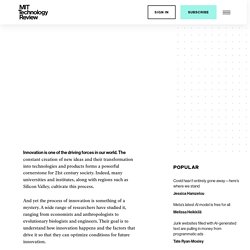
The constant creation of new ideas and their transformation into technologies and products forms a powerful cornerstone for 21st century society. Indeed, many universities and institutes, along with regions such as Silicon Valley, cultivate this process. And yet the process of innovation is something of a mystery. A wide range of researchers have studied it, ranging from economists and anthropologists to evolutionary biologists and engineers. Their goal is to understand how innovation happens and the factors that drive it so that they can optimize conditions for future innovation.
This approach has had limited success, however. Second-Level Thinking: What Smart People Use to Outperform. “Experience is what you got when you didn’t get what you wanted.”
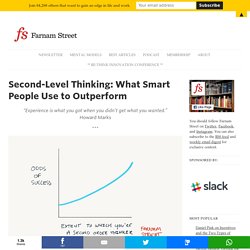
Howard Marks Successful decision making requires thoughtful attention to many separate aspects. Decision making is as much art as science. Una definizione della creatività - nuovoeutile. Perché dovremmo chiederci che cosa sappiamo fare bene. C’è qualcosa – una cosa qualsiasi – che sai fare bene?
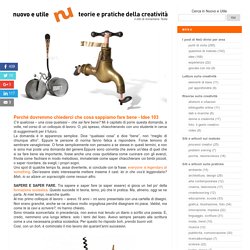
Mi è capitato di porre questa domanda, a volte, nel corso di un colloquio di lavoro. O, più spesso, chiacchierando con uno studente in cerca di suggerimenti per il futuro. The Secret to Creativity, Intelligence, and Scientific Thinking: Being Able to Make Connections - When we shared this image from the @buffer Twitter account a while back, it got me thinking.

The Tweet resulted in over 1,000 retweets, which seems like an indication that it resonated with a lot of people. There’s a key difference between knowledge and experience and it’s best described like this: Leonardo’s Brain: What a Posthumous Brain Scan Six Centuries Later Reveals about the Source of Da Vinci’s Creativity. By Maria Popova How the most creative human who ever lived was able to access a different state of consciousness.
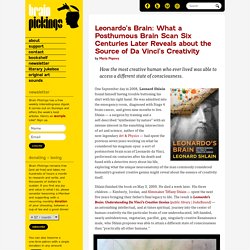
One September day in 2008, Leonard Shlain found himself having trouble buttoning his shirt with his right hand. He was admitted into the emergency room, diagnosed with Stage 4 brain cancer, and given nine months to live. Debunking the Myth of the 10,000-Hours Rule: What It Actually Takes to Reach Genius-Level Excellence. By Maria Popova How top-down attention, feedback loops, and daydreaming play into the science of success.
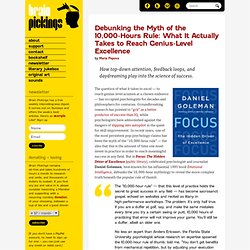
We spoke to 500 founders about how big ideas get realised (or not.) Here’s what we learnt. This article is based on research by Peter Koenig.

Charles Davies has also been instrumental in developing the ideas here. Black Monday On a cold Monday morning at my company’s all-hands meeting I stood pale-faced in front of the team and updated them on our situation. The business was likely to close in a matter of weeks. Possibly days. The Art of Looking: What 11 Experts Teach Us about Seeing Our Familiar City Block with New Eyes. By Maria Popova “Attention is an intentional, unapologetic discriminator.
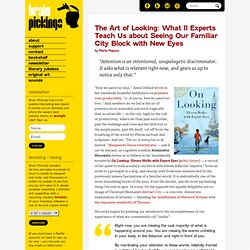
It asks what is relevant right now, and gears us up to notice only that.” “How we spend our days,” Annie Dillard wrote in her timelessly beautiful meditation on presence over productivity, “is, of course, how we spend our lives.” Why “Psychological Androgyny” Is Essential for Creativity. By Maria Popova “Creative individuals are more likely to have not only the strengths of their own gender but those of the other one, too.”
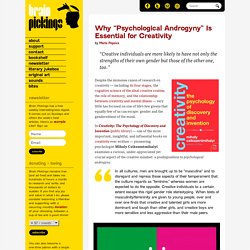
Despite the immense canon of research on creativity — including its four stages, the cognitive science of the ideal creative routine, the role of memory, and the relationship between creativity and mental illness — very little has focused on one of life’s few givens that equally few of us can escape: gender and the genderedness of the mind. In Creativity: The Psychology of Discovery and Invention (public library) — one of the most important, insightful, and influential books on creativity ever written — pioneering psychologist Mihaly Csikszentmihalyi examines a curious, under-appreciated yet crucial aspect of the creative mindset: a predisposition to psychological androgyny. In Praise of Melancholy and How It Enriches Our Capacity for Creativity.
By Maria Popova How the American obsession with happiness at the expense of sadness robs us of the capacity for a full life.
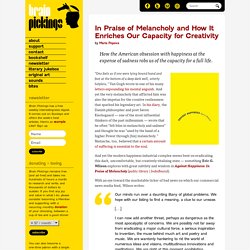
“One feels as if one were lying bound hand and foot at the bottom of a deep dark well, utterly helpless,” Van Gogh wrote in one of his many letters expounding his mental anguish. And yet the very melancholy that afflicted him was also the impetus for the creative restlessness that sparked his legendary art. T. S. Eliot on Idea Incubation, Inhibition, and the Mystical Quality of Creativity + a Rare Recording. Kierkegaard on Anxiety & Creativity.
By Maria Popova. Pixar Cofounder Ed Catmull on Failure and Why Fostering a Fearless Culture Is the Key to Groundbreaking Creative Work. By Maria Popova Why the greatest enemy of creative success is the attempt to fortify against failure. Ray Bradbury on Writing, Emotion vs. Intelligence, and the Core of Creativity. By Maria Popova “You can only go with loves in this life.” Between 1973 and 1974, journalist James Day hosted the short-lived but wonderful public television interview series Day at Night.
Among his guests was the inimitable Ray Bradbury (August 22, 1920–June 5, 2012) — beloved writer, man of routine, tireless champion of space exploration, patron saint of public libraries, passionate proponent of doing what you love and writing with joy. The Taste Gap: Ira Glass on the Secret of Creative Success, Animated in Living Typography. Twilight Zone Creator Rod Serling on Where Good Ideas Come From. A 5-Step Technique for Producing Ideas circa 1939. Why Great Ideas Get Rejected. Have you ever debuted an exciting new idea to the world only to receive a lukewarm or even highly critical response?
Well, get used to it. Mounting evidence shows that we all possess an inherent bias against creativity. The good news is there’s something we can do about it. O n May 29, 1913 in Paris, Igor Stravinsky debuted perhaps his greatest work, The Rite of Spring ballet. Up until that point, most ballets were graceful and elegant, full of traditional music. Within minutes of the show’s start, the audience began to boo the performers.
Of course, history would vindicate Stravinsky. Similar rejections can leave us wondering what we did wrong or why others just couldn’t appreciate our creative idea. Creativity Requires an Element of Novelty. Is there a bias against creativity? Amanda Enayati People routinely reject and show bias against creative ideas, Amanda Enayati says Poll of CEOs: Creativity is the single most important leadership trait for success People reject creativity because of uncertainly -- but it's needed to help us through uncertainty Innovator: Build confidence by treating fear of creativity like a phobia of heights or snakes Editor's note: CNN contributor Amanda Enayati ponders the theme of seeking serenity: the quest for well-being and life balance in stressful times.
(CNN) -- Creativity has taken center stage in recent years, with a slew of books, articles and TED talks extolling the virtues of imagination and exhorting young and old to go out and exercise their creative muscle. In a 2010 IBM poll of CEOs worldwide, creativity was identified as the single most important leadership trait for success, enabling businesses to rise above an increasingly complex environment. Master the art of solitude and blast your creativity into the stratosphere. Is a more disorganized brain a more creative brain?
In Where Good Ideas Come From: The Natural History of Innovation, Steven Johnson posits that “the more disorganized your brain is, the smarter you are” in reference to the results of a neuroscience experiment by Robert Thatcher. Across the board, in Johnson’s book and other sources it seems pretty clear that creativity is messy. Ideas need to be sloshing around or crashing in to one another to produce breakthroughs: Johnson cites research showing that the volume of ideas bouncing about make large cities disproportionately more creative than smaller towns.Having multiple hobbies allows your brain to subconsciously compare and contrast problems and solutions, forming new connections at the margins of each.Similarly, reading multiple books at the same time vs serially lets your brain juxtapose new ideas and develop new connections.Wandering minds are more creative.Studying a field “too much” doesn’t limit creativity — it does the opposite.
How far will you take your imagination today? Do Small Rebellions Increase Our Creativity? I walked a Formula One race track last fall in Abu Dhabi, in the blistering evening desert heat. The city of Abu Dhabi opens the track a couple of days a week for bikers and joggers. I, however, was walking, due to a lack of appropriate sportswear, gasping for air, and happy to make it through even just one round.